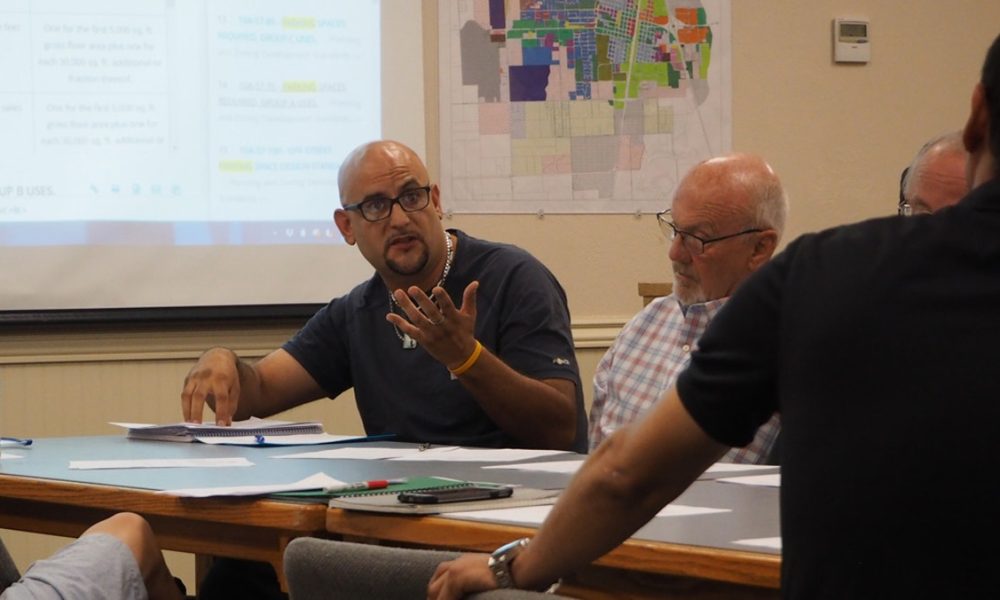 Marijuana ad hoc committee members discuss recommendations for governing future medical and recreational marijuana operations in Ontario. The proposed city ordinances would take effect if Ontario voters choose to legalize marijuana in November. (File/The Enterprise)
Marijuana ad hoc committee members discuss recommendations for governing future medical and recreational marijuana operations in Ontario. The proposed city ordinances would take effect if Ontario voters choose to legalize marijuana in November. (File/The Enterprise)
ONTARIO — Buying legal marijuana inside Ontario city limits is closer to reality than ever.
Voters soon will get ballots that include a measure to repeal the ban on recreational marijuana sales in Ontario. Even if voters approve the measure Nov. 6, a ban would remain in place for the rest of Malheur County.
Ahead of the vote, Ontario city officials are crafting regulations to control the marijuana business if it does come to town. The rules would govern where dispensaries could set up and how they could operate
The public gets its first crack at those regulations next week in a hearing scheduled by the Ontario Planning Commission. The hearing will be at 7 p.m. Wednesday, Oct. 10, at City Hall. Any citizen can then remark on the proposed rules. This won’t be the time, though, to debate the repeal itself.
“The meeting is not about legalizing marijuana. That’s going to be up to the people,” said Dan Cummings, the city’s community development director. “This is about what codes will be followed.”
Cummings said his staff has drafted different scenarios to govern where in the city dispensaries would be allowed.
Cummings said the draft regulations include the recommendations from city staff and the city Marijuana Ad Hoc Committee, a group of seven who worked through the summer to consider how to regulate a new industry for Ontario.
The proposed regulations to be considered by the planning commission would allow commercial marijuana dispensaries, cultivation facilities and manufacturing in specific zones. Such businesses would need permits and licenses from the planning department, the city and the state.
As proposed, recreational marijuana businesses could operate in the commercial and industrial areas along Oregon Street, the industrial area along the west side of Interstate 84 and the commercial zones along East Idaho Avenue. There would also be a small area for marijuana businesses in the commercial and industrial patches along Oregon Highway 201.
Cummings said the city wouldn’t cap the number of marijuana businesses in town. Instead, the zoning laws and licensing requirements would serve as a limit, he said.
Cummings is proposing that marijuana businesses in certain zones be at least 350 feet apart. That would allow more businesses than proposed by the citizen committee, which wanted marijuana retailers no closer than 1,000 feet to each other. Under either restriction, only a certain number of retail businesses could operate in Ontario.
City Manager Adam Brown said the city has not calculated the maximum number of retail businesses that would be possible under each restriction.
“It all depends on the where the first application for a dispensary gets located,” said Brown. “Where we will put buffers all depends where that first one gets in and the next one, and the one after that,” he said. “We’ll start implementing buffers between those dispensaries.”
Brown said there’s a high likelihood that there will be a buffer between retail shops.
“They will want to see something, whether it’s 250, 300, or a thousand feet,” he said. “I don’t know which direction the planning commission and council will go.”
Brown said that, overall, the staff recommendations are “more open,” whereas the ad hoc committee “has targeted the East Idaho market area” as the only area for setting up marijuana businesses.
By staff recommendations, there would be more opportunities for marijuana shops to set up, Brown said. There would be more competition between retailers.
“The questions is, do we want them everywhere?” said Brown.
The city staff and ad hoc committee both plan to prohibit marijuana businesses in residential areas, but the extent of a buffer is unsettled. Cummings’ staff proposed pot businesses be kept 250 feet away from residential areas while the ad hoc committee proposed a 500-foot buffer.
In addition to restricting marijuana operations to the city’s industrial and commercial zones, the draft ordinance establishes a 1000-foot buffer to prevent businesses from being too close to schools, daycare centers, public parks and other public facilities.
The item on the ballot would legalize all marijuana operations. While state law requires that medical dispensaries be at least 1,000 feet from one another, no buffer has been established between medical and recreational marijuana dispensaries.
“A medical marijuana dispensary can be next door to a recreational dispensary,” said Cummings.
Marijuana businesses would have to meet other land-use codes and comply with state regulation as well.
“For any commercial marijuana function – whether it be growing, selling, retail – they need to have a conditional use permit and a city business license to operate,” said Cummings.
The conditional use permit would ensure that businesses operate in buildings that can provide customers with enough restrooms and parking. It also gives city officials an opportunity to control how marijuana operations run, said Cummings.
A draft ordinance prepared by City Attorney Larry Sullivan would require both medical and recreational entities to possess a local business license. Medical businesses would pay no fee but the license would cost recreational facilities $5,000.
“I think the theory is that the city is going to want to monitor the businesses in town that are producing, processing, selling and growing recreational marijuana that is also operating as medical marijuana dispensaries,” said Sullivan. “The business license will not include those growing their own plants for personal use.”
Sullivan said his draft doesn’t include a residency requirement as suggested by the ad hoc committee. The committee wanted only those who have lived in Ontario two years to be eligible to open recreational marijuana businesses.
“There are still unresolved issues both by the planning commission and city council,” Sullivan said. “Ultimately, it’s up to city council to make the final decision.”
He said he is intending the council to have regulations go into effect the same date that a voter-passed repeal would take hold – Jan. 1.
One concern is that an influx of marijuana could mean an influx of crime.
While the city has had discussions with those in leadership in law enforcement, it hasn’t determined how it would police any new marijuana industry.
“We haven’t spent the money yet,” said Brown. “We don’t want to propose an outcome. So that’s why we’ve been working the zoning and regulations side of (legalization). If it passes, we’ll go to phase two, and undoubtedly, the city will want to spend some money on law enforcement.”
However, it might take a while before the city receives any tax revenue from legal marijuana sales, said Brown.
Malheur County District Attorney David Goldthorpe said the level of crime “depends on the crowd.”
“The crimes wouldn’t be based on the presence of marijuana alone, but the type of people it attracts,” Goldthorpe said. “There could be a huge influx of people with those who choose to stay.”
Goldthorpe said his main worry is the effect legalization would have on youth access to marijuana. He said the more readily available substances are to adults, the more accessible it is to youth.
“My only concern is its effects on juvenile developing brains,” he said. “Juvenile access to marijuana is a big problem.”
Goldthorpe said that the state addresses this through sting operations.
The Oregon Liquor Control Commission, which regulates marijuana, performs random marijuana sales spot checks, sending in undercover and sometimes underage decoys to check the businesses on their age verification processes.
However, sting operations don’t stop kids from getting access to drugs at home, said Goldthorpe.
Reporter Kristine de Leon: [email protected] or 541-473-3377




